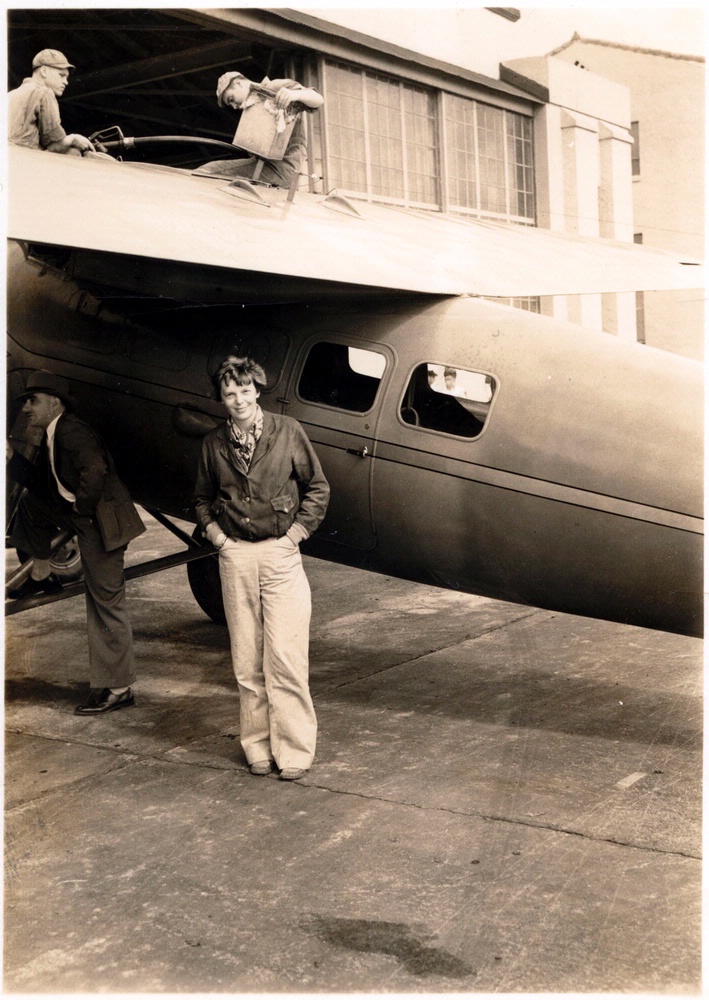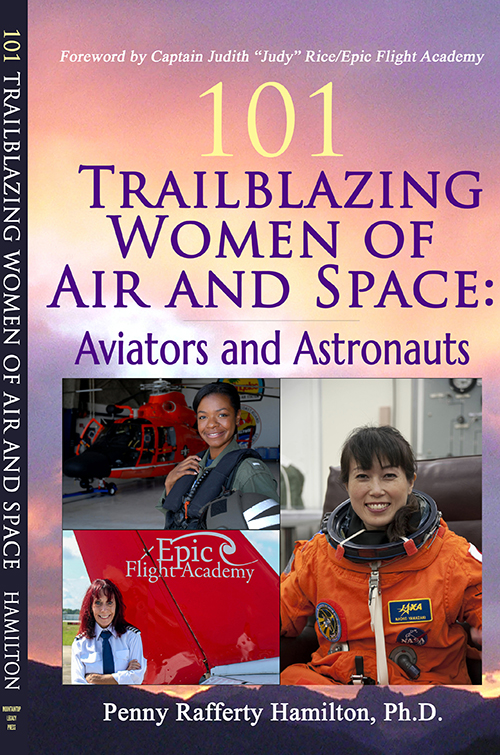By Penny Rafferty Hamilton, Ph.D.
Amelia Earhart knew ten pilots had died earlier attempting to fly solo from Hawaii to California over the vast Pacific Ocean. According to a detailed account on Hawaii Aviation, because of weather delays, Amelia took a short nap on that rainy January day. Her red Vega monoplane was similar to the trusty plane she flew earlier in May, 1932, as the first woman to fly solo across the Atlantic Ocean. This second plane was modified with extra tanks for 520 gallons of fuel. Amelia’s trusted friend, the famed air-racing and Hollywood stunt pilot, Paul Mantz, had earlier hoovered in the hangar, overseeing every detail of fueling and pre-flight for her epic flight.

Shortly after 4:00 P.M., Amelia, wearing a brown flying suit she had designed, arrived at the Wheeler Field hangar with sandwiches, boiled eggs, tomato juice, hot cocoa, chocolate, and water for her flight. Paul continued to supervise. A.E. donned a life vest. She climbed into the Vega’s now small cockpit. After a few wise words of advice, Paul stepped back from the shiny, red monoplane. Amelia started up the engine which sprang to life. She checked her panel instruments and movable surfaces. After her “thumbs-up,” the wheel chocks were quickly removed. She carefully taxied out of the hangar. The grass beyond the apron was still very wet and soggy. Amelia applied additional power to her very heavy plane. Wet mud and grass clogged the airplane tailskid. Mantz motioned to Amelia to level off and quickly head into the wind to avoid getting bogged down.
Amelia nodded, signaling she understood. She taxied into position on the runway without further complications. Once ready for take-off, intrepid Amelia pushed the throttle forward. Under the 6,500 pound load, her Vega slowly lifted off the runway. Without the media hype of her earlier record-setting attempts, few knew of this dangerous flight from Wheeler field to Oakland, California yet. Once airborne, her bright red plane quickly faded into the overcast, gray sky toward Diamond Head and the Pacific Ocean.
Just as she had done with her solo Atlantic Ocean flight, she would use her compass to navigate. Using the term “dead reckoning” sounds so ominous. However, in those relatively early years of aviation, the process of calculating one’s position, especially at sea, by estimating the direction and distance traveled rather than by using landmarks, astronomical observations, or electronic navigation methods was the norm.
Earhart monitored her instruments religiously. Every half hour, she transmitted position reports with her radio transmitter. By now, thanks to her husband, George Putnam, a public relations guru, word had “leaked” out about the brave Amelia and her very dangerous flight. The world tuned in. Those with short wave radio sets in Hawaii heard her calm, feminine voice reporting from the sky. “This is KHABQ. Everything is OK.”
Honolulu’s KGU radio station broadcast her messages to listeners. Remember, no other pilot had successfully flown from the remote Hawaiian Islands across the Pacific Ocean to the mainland of the United States. This was literally uncharted sky.
With each passing half-hour report, more and more of the world tuned in to follow the flight of the brave thirty-eight year old aviatrix. Amelia flew at 8,000 feet most of the 2,000+ nautical mile flight. Amelia flew over several steamers which all quickly reported the sighting. She even circled over one to confirm that ship’s location on her very carefully charted route. Her navigation was right on the mark. She was happy for the occasional cloud to keep her alert during the long, long hours of boredom and sameness of ocean and sky.
Finally, after two false sightings of the West Coast through occasional fog banks, there it was. She saw land in front of her. A mix of joy and relief filled her entire body. She was so gleeful and ready to complete her record-setting feat. Amelia’s trusty Vega, navigation skills, and careful planning brought her safely to the Oakland Airport. After 18+ hours of her epic flight and more than thirty-six radio reports during the very dangerous journey, Amelia Earhart became the first person in the world to accomplish the first solo, non-stop flight from the isolated Pacific Hawaiian islands connecting them to the United States mainland by air. Of course, there was no comparison between the small send-off crowd of mostly friends, mechanics, and U.S. Army personnel at Wheeler Field to the tumultuous reception for the woman who showed the world a new picture of female strength and skill when she landed at Oakland airport.
Even in the air approaching the airport, over the purring of the Vega’s engine and the endless hissing from the constant air rushing into her face from a ventilator which had blown open early in the epic flight, Amelia heard the loud cheers and honking horns. As the airport clearly came into focus, she saw the huge crowd of over 5,000 people lining the airfield. She saw the endless circle of automobiles surrounding the airport. As she came in for landing, the cheering grew to deafening levels. Hats were tossed in the air. People clapped and danced in excitement. The scarlet Vega miraculously rolled to a stop on Oakland Airport around 12:50 p.m., January 12, 1935. After 18 hours and 15 minutes in the air, terra firma looked good.
Amelia did not win a huge prize for her world-record success. She continued to build her reputation and legacy as one of the world’s most famous flyers. She secured her place in aviation history which only motivated her to attempt more. She demonstrated the power of the airplane to unite the world. She is quoted as saying, “I wanted the flight just to contribute. I could only hope one more passage across that part of the Pacific would mark a little more clearly the pathway over which an air service of the future will inevitably fly.”
According to a May, 2021, Hawaiian commercial aviation report, there are about 151 departures each day. An extra 118 weekly departures have been added versus the same week in 2019. The ubiquitous B737-800 is the most-used aircraft, although the A330-200 is only marginally behind in passenger carry. According to preliminary statistics released by the Hawaii Tourism Authority (HTA), a total of 629,681 visitors arrived by air service to the Hawaiian Islands in May 2021, mainly from the U.S. West and U.S. East. Amelia’s January, 1935, solo flight over the Pacific Ocean set the stage for today’s flights. She proved aviation and airports can connect the world.




